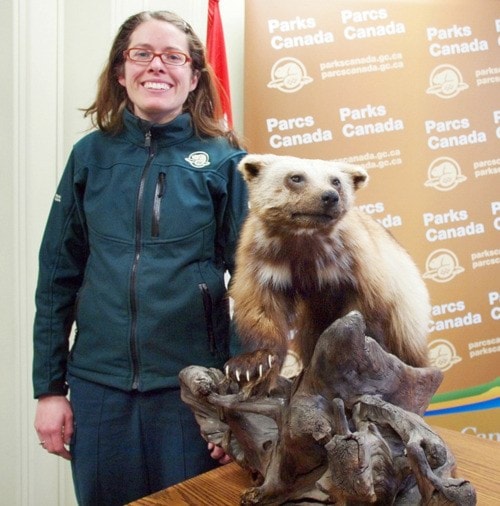Parks Canada study is looking at the impact of the Trans-Canada Highway on the wolverine.
Kelsey Furk has encountered wolverines in the wild twice. Once, she was skiing in the Wapta area of Banff National Park when she saw one climbing a mountain.
“It’s strange when you see an animal in the alpine that looks like a bear, but isn’t a bear,” she said. “He was climbing over a substantial peak, which was impressive to see.”
The second time was while doing field work near Blue River, B.C. “I was looking for a way back to the truck and he showed me the way.”
These days, Furk is researching wolverines as part of a Parks Canada study looking at the presence and behavior of wolverines along the Trans-Canada Highway corridor. It’s a study that started as a pilot project last year and will continue at least into next year.
The study is looking at whether or not wolverines are crossing the highway so that should the Trans-Canada be widened, any mitigations put in place will keep the wolverine in mind.
“Wolverines have been identified as being susceptible to fragmentation to human development, and that includes transportation corridors,” Furk said. “We want to make sure they’re crossing the highway.”
Wolverines are elusive animals that spend their lives wandering over mountains and into valleys in search of food. “They’re extremely food focused,” said Furk. “Weighing about 12 to 16 kilograms, they mostly eat carrion but have been known to take down much larger animals like caribou and goats. Males have home ranges of up to 1,580 square-kilometers, while females are less adventurous.”
To study wolverines, Parks Canada researchers set up bait at seven different stations near the Trans-Canada Highway. They ski or snowmobile in carrying in a piece of bait and some lure that Furk described as “... the most foul smelling, disgusting stuff that you’ve ever experienced ... Even in a totally sealed container and wrapped in three different bags, you still reek like skunk for days afterwards.”
The bait is place two meters up a tree and the lure draws the animals to the area. The tree is wrapped in barbed wire, which collects hair samples that are then sent off for testing.
“We are hoping to collect DNA samples to determine relatedness of wolverines in the area and in the longer term see if there are any fragmentation issues across the Trans-Canada,” Furk said.
Each station has a camera nearby that is triggered whenever an animal passes by. In one amazing capture a wolverine caught on to a loose piece of rope and spent the next three days playing with it. The video, Dances With Wolverines, has been played on countless television stations and websites.
“I don’t like the word playing because I’m a biologist,” said Furk. “It’s very likely that rope was quite smelly.
“It’s pretty unusual behavior.”
Wolverines are largely solitary animals but another video (that isn’t on YouTube) shows two wolverines at one of the stations. “We think this was a family group. We’re not sure but when we find out we’ll let you know,” said Furk.
Columbia Basin Trust and Fish and Wildlife Compensation Program conducted a study on wolverines in the North Columbia Mountains in the mid-1990s, in collaboration with Parks Canada, the Ministry of Forests and the Habitat Conservation Trust Fund. It looked at the home range size of a wolverine, the cause of mortality, habitat use and population estimates.
It estimated there is one wolverine per every 167 square kilometers in the northern Selkirks. Furk said there was likely more inside Glacier National Park itself. “It’s possible it forms a bit of refuge for wolverines.”
Wolverines are Blue-listed as a species of special concern by the provincial government. Because they feast on carrion, they require a proper predator-prey balance to eat properly. They eat the scraps left over by other predators, so a decline in either number will impact the food available to the wolverine.
Human development also impacts the wolverine by fragmenting its habitat with roads, towns and more. They are also susceptible to disturbance by recreationalists, particularly while denning.
“We ask that people if they see a wolverine track not to follow it and if they see a den, please leave the area,” said Furk.
Climate change may also be a factor, Furk said. Wolverines need a persistent spring snow pack in spring time and they may also require a cold, harsh winter to help kill off ungulates (deer, moose, caribou, etc.) for them to eat.
The 1990s study showed some wolverines were crossing the Trans-Canada Highway, but not as many as would have if it wasn’t there, said Furk. Two wolverines were hit by traffic during the study period. More recently, a Parks Canada employee reported a wolverine sighting on the highway.
To help see if they are crossing the highway, the researchers will be looking at following their tracks when the snow eases up. A wolverine travels in a loping fashion, creating a three-track pattern in the snow - the middle track is in fact two paws. The five toe pattern and the sign of claws can also identify the tracks.
Parks Canada is asking members of the public to send in reports of track sightings to wolverine2012@pc.gc.ca. Cards showing how to identify tracks are available.
“What makes a wolverine track distinctive in the mountains is that its traveling; they’re not going from tree to tree,” said Furk. “If you see a track that is bigger than a marten, is near the alpine and looks like it’s on a mission to get somewhere else, it’s quite possible it’s a wolverine.”
So far wolverines have been spotted at five out seven bait stations. The study will continue into next year and there are plans to have 12 stations along the Trans-Canada Highway corridor from Revelstoke to Quartz Creek. Similar studies are being done in the Rocky Mountains and southern Selkirks.
For more information visit www.parkscanada.gc.ca/wolverine.
